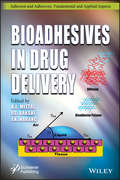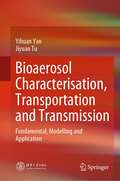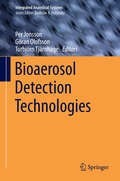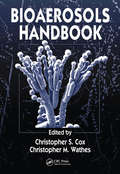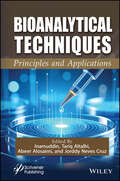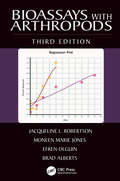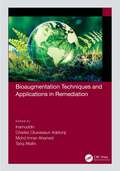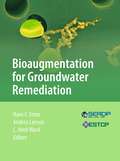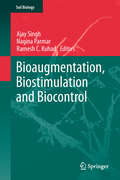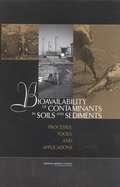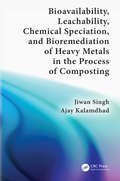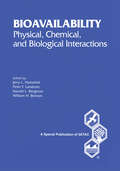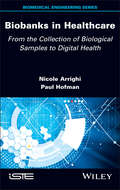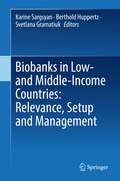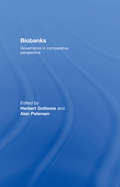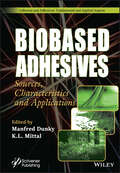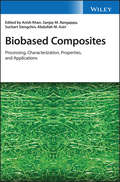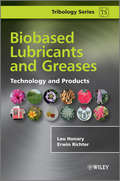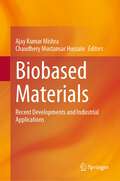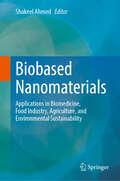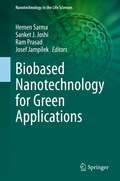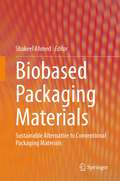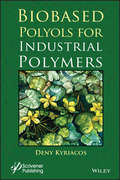- Table View
- List View
Bioadhesives in Drug Delivery (Adhesion and Adhesives: Fundamental and Applied Aspects)
by K. L. Mittal I. S. Bakshi J. K. NarangUnderstanding the phenomenon of bioadhesion i.e. its theories or mechanism(s) are of critical importance in developing optimum bioadhesive polymers (used in bioadhesives). Such bioadhesive polymers are the key for exhibiting the process of bioadhesion, controlled/sustained release of drugs, and drug targeting. The use of bioadhesives restricts the delivery system to the site of interest and thus offers a useful and efficient technique for targeting a drug to the desired location for a prolonged duration. This book addresses the various relevant aspects of bioadhesives in drug delivery in an easily accessible and unified manner. The book containing 12 chapters written by eminent researchers from many parts of the globe is divided into three parts: Part 1: Fundamental Aspects; Part 2: Bioadhesive Formulations; Part 3: Drug Delivery Applications. The topics covered include: Theories and mechanisms of bioadhesion; bioadhesive polymers for drug delivery applications; methods for characterization of bioadhesiveness of drug delivery systems; bioadhesive films and drug delivery applications; bioadhesive nanoparticles; and bioadhesive hydrogels and applications ocular biodhesive drug delivery systems; buccal bioadhesive drug delivery systems; gastrointestinal bioadhesive drug delivery systems ; nasal bioadhesive drug delivery systems; vaginal drug delivery systems; pulmonary bioadhesive drug delivery systems.
Bioaerosol Characterisation, Transportation and Transmission: Fundamental, Modelling and Application
by Jiyuan Tu Yihuan YanThis book aims to predict and model the transport of bioaerosols, identify their transmission characteristics, and assess occupants’ infection risks. Although existing epidemiological books provide fundamental infection rate of existing diseases, the ability of predicting emerging disease transmission in the air and assessing occupants’ infection risks to the bioaerosols is significantly lacking. This book is considered as a professional book that provides in-depth discussion of the aforementioned issues and provides potential approaches to solve these issues would be highly demanded by readers in this emerging research field. This book offers essential and systematic analysis on the fate of bioaerosols from their release in the air to the final destination in human’s respiratory systems through direct 3D visualizations techniques. It also provides quantifiable method to assess each occupant’s infection risks to the infectious bioaerosols in indoor environments. The readers will gain essential fundamental characteristics of bioaerosols (active time, viability, etc.) and will gain the advanced skills on how to integrate these properties into numerical modeling and assess the occupants’ exposure risks.
Bioaerosol Detection Technologies (Integrated Analytical Systems)
by Per Jonsson Göran Olofsson Torbjörn TjärnhageThis book is intended to give technological background and practical examples, but also to give general insight into the on-going technology development in the area of biodetection. The content is therefore suitable for an array of stakeholders (decision makers, purchasing officers, etc. ) and end-users of biodetection equipment within the areas of health, environment, safety and security, and military preparation. The book is divided into three sections. The first section discusses the fundamental physical and biological properties of bioaerosol's. The second section goes into more detail and discusses in-depth the most commonly used detection principles. The third section of the book is devoted to technologies that have been used in standoff applications. The last section of the book gives an overview of trends in bioaerosol detection. The reader of this book will gain knowledge about the different biodetection technologies and thus better judge their capabilities in relation to desired applications.
Bioaerosols (Indoor Air Research Ser. #2)
by Harriet A. BurgeWritten by an illustrious group of experts in microbiology and aerobiology, Bioaerosols brings together current information on the nature and health effects of bioaerosol-related problems. The book presents up-to-date coverage of methods for sampling and analysis, as well as various approaches to the investigation of health problems caused by exposure to biological contaminants in indoor air. Its comprehensive treatment of the various aspects of this subject makes it a valuable reference for industrial hygienists, public health officials and researchers, and physicians interested in environmentally caused disease.
Bioaerosols Handbook
by Christopher S. Cox; Christopher M. WathesThis comprehensive handbook provides up-to-date knowledge and practical advice from established authorities in aerosol science. It covers the principles and practices of bioaerosol sampling, descriptions and comparisons of bioaerosol samplers, calibration methods, and assay techniques, with an emphasis on practicalities, such as which sampler to use and where it should be placed. The text also offers critiques concerning handling the samples to provide representative and meaningful assays for their viability, infectivity, and allergenicity. A wide range of microbes-viz., viruses, bacteria, fungi and pollens, and their fragments-are considered from such perspectives.Bioaerosols Handbook is divided into four parts, providing a wide-ranging reference work, as well as a practical guide on how best to sample and assay bioaerosols using current technology.
Bioaerosols: Assessment and Control
by Janet Macher American Conference of Governmental Industrial Hygienists StaffExpanding far beyond its predecessor, this new text offers a comprehensive guide to the assessment and control of bioaerosols in the full range of contemporary workplaces. The popular Guidelines notebook, originally published by ACGIH® in 1989, offered 100 pages of information. The new volume is more than quintuple the size of the earlier version. Although the indoor environment remains a focus of concern, much of the information in this publication has application beyond office environments. The prominence of saprophytic microorganisms remains; however, more attention has been given to other important biological agents (e.g., arthropod and animal allergens, infectious agents, and microbial volatile organic compounds). In addition, fuller descriptions were provided for microbial toxins and cell wall components that may cause health effects. The new Bioaerosols: Assessment and Control was written by the ACGIH® Bioaerosols Committee with contributions from other experts in specific areas. The diversity in professional backgrounds and specialties of the authors ensures comprehensive, informed coverage of a broad spectrum of critical issues in the topic area. Industrial hygienists, indoor environmental specialists, occupational health professionals, teachers, and managers will find this new text to be one of the most comprehensive guides to bioaerosols ever produced.
Bioanalytical Techniques: Principles and Applications
by Inamuddin Tariq Altalhi Jorddy Neves Cruz Abeer AlosaimiThe book provides a comprehensive guide that covers the fundamental principles and methodologies of essential bioanalytical techniques. Bioanalytical Techniques: Principles and Applications is a comprehensive and authoritative book that explores the principles, methodologies, and applications of bioanalytical techniques in the field of life sciences. The book covers a wide range of analytical techniques used for the characterization, quantification, and analysis of biological samples, including proteins, nucleic acids, metabolites, and biomarkers. Using a multidisciplinary approach by integrating concepts from biochemistry, molecular biology, analytical chemistry, and biotechnology, this book provides a solid foundation in the fundamental principles underlying various bioanalytical techniques, such as spectroscopy, chromatography, electrophoresis, immunoassays, mass spectrometry, and biosensors. Each technique is explained in detail, including its working principles, instrumentation, data analysis, and practical considerations. The book incorporates case studies, examples, and practical tips to illustrate how these techniques are used to solve biological problems and address research questions. It also discusses emerging trends and technologies in bioanalytical techniques, such as microfluidics, nanotechnology, and omics approaches. Readers will find the book: Offers comprehensive coverage of bioanalytical techniques, encompassing a wide range of methodologies, instruments, and applications through real-world case studies; Adopts a multidisciplinary approach, integrating concepts from biochemistry, molecular biology, analytical chemistry, and biotechnology; Explores emerging trends and technologies in bioanalytical techniques, such as microfluidics, nanotechnology, omics approaches, and bioinformatics; Includes practical guidance, troubleshooting tips, and common challenges in bioanalysis, equipping readers with valuable insights and strategies for successful experimentation and data interpretation; Features contributions from renowned experts and leaders in the field, ensuring the content is authoritative, up-to-date, and reflects the latest advancements in bioanalytical techniques. Audience Biochemists, biologists, chemists, and medical and pharmaceutical professionals interested in biomolecules, enzymology, and biochemical pathways.
Bioassays with Arthropods
by Efren Olguin Brad Alberts Jacqueline Robertson Moneen JonesImagine a statistics book for bioassays written by a statistician. Next, imagine a statistics book for bioassays written for a layman. Bioassays with Arthropods, Third Edition offers the best of both worlds by translating the terse, precise language of the statistician into language used by the laboratory scientist. The book explains the statistical basis and analysis for each kind of quantal response bioassay in just the right amount of detail. The first two editions were a great reference for designing, conducting, and interpreting bioassays: this completely revised and updated third edition will also train the laboratory scientist to be an expert in estimation of dose response curves. New in the Third Edition: Introduces four new Windows and Apple-based computer programs (PoloJR, OptiDose, PoloMixture and PoloMulti) for the analyses of binary and multiple response analyses, respectively Replaces out-of-date GLIM examples with R program samples Includes a new chapter, Population Toxicology, and takes a systems approach to bioassays Expands the coverage of invasive species and quarantine statistics Building on the foundation set by the much-cited first two editions, the authors clearly delineate applications and ideas that are exceptionally challenging for those not already familiar with their use. They lead you through the methods with such ease and organization, that you suddenly find yourself readily able to apply concepts that you never thought you would understand. To order the PoloSuite computer software described in Bioassays with Arthropods, Third Edition, use the order form found at www.leora-software.com or contact the LeOra Software Company at leorasoftware@gmail.com.
Bioaugmentation Techniques and Applications in Remediation
by InamuddinIt has been observed that rapid population expansion has raised the amount of anthropogenic activity, resulting in high levels of pollution in water, air, and solid waste as well as an increase in the pressure placed on agricultural lands. Bioaugmentation Techniques and Applications in Remediation provides detailed information on bioaugmentation approaches for the remediation of sediments, water, and soil polluted with organic and inorganic pollutants. Practical applications of bioaugmentation techniques performed in restricted systems under controlled conditions, laboratory investigations, and in the field are addressed. Special emphasis is placed on the applications of nanomaterials in combination with bioaugmentation techniques for enhanced bioremediation efficiency. FEATURES Explores abiotic and biotic factors that enhance and facilitate environmental remediation of contaminants Provides a primer on the elementary microbial processes entailed in bioaugmentation Summarizes methods and approaches for executing bioaugmentation technology Details commercially available products and instrumentation This book is an ideal resource for researchers, students, and engineers working in materials science and bioremediation.
Bioaugmentation for Groundwater Remediation (SERDP ESTCP Environmental Remediation Technology #5)
by C. Herb Ward Hans F. Stroo Andrea LeesonThis volume provides a review of the past 10 to 15 years of intensive research, development and demonstrations that have been on the forefront of developing bioaugmentation into a viable remedial technology. This volume provides both a primer on the basic microbial processes involved in bioaugmentation, as well as a thorough summary of the methodology for implementing the technology. This reference volume will serve as a valuable resource for environmental remediation professionals who seek to understand, evaluate, and implement bioaugmentation.
Bioaugmentation, Biostimulation and Biocontrol (Soil Biology #10)
by Ajay Singh Ramesh C. Kuhad Nagina ParmarBioaugmentation, biostimulation and biocontrol approaches using microbial inoculants, biofertilizers, biochemicals and organic amendments improve soil biology, fertility and crop productivity by providing plant growth-promoting nutrients and suppressing soil-borne diseases and plant-parasitic nematodes. Our knowledge of microbial diversity and its function in soils has been increased tremendously due to the availability of a wealth of data gained through recent advances in the development of molecular methods and metagenomics for the evaluation of microbial diversity and functions in the rhizosphere environment of soil. Chapters dealing with the application of biofertilizers and organic amendments are contributed by experts - authorities in the area of soil science including microbiology and molecular biology - from academic institutions and the industry.
Bioavailability Of Contaminants In Soils And Sediments: Processes, Tools, And Applications
by Committee on Bioavailability of Contaminants in Soils SedimentsBioavailability refers to the extent to which humans and ecological receptors are exposed to contaminants in soil or sediment. The concept of bioavailability has recently piqued the interest of the hazardous waste industry as an important consideration in deciding how much waste to clean up. The rationale is that if contaminants in soil and sediment are not bioavailable, then more contaminant mass can be left in place without creating additional risk. A new NRC report notes that the potential for the consideration of bioavailability to influence decision-making is greatest where certain chemical, environmental, and regulatory factors align. The current use of bioavailability in risk assessment and hazardous waste cleanup regulations is demystified, and acceptable tools and models for bioavailability assessment are discussed and ranked according to seven criteria. Finally, the intimate link between bioavailability and bioremediation is explored. The report concludes with suggestions for moving bioavailability forward in the regulatory arena for both soil and sediment cleanup.
Bioavailability, Leachability, Chemical Speciation, and Bioremediation of Heavy Metals in the Process of Composting
by Jiwan Singh Ajay KalamdhadCurrently, it is a serious concern to manage waste in the environment. Therefore, detailed knowledge of heavy metals, their eco-toxicological and health effects and ecofriendly approaches for their immobilization and detoxification is urgently required to control and minimize the environmental pollution. Composting is one of the popular methods in waste management and there are a lot of issues pertaining to composting. One of it is the leaching of heavy metals. This book discusses thoroughly, the availability, leachability and the speciation of heavy metals in the entire process of composting.
Bioavailability: Physical, Chemical, and Biological Interactions
by William H. Benson Jerry Hamelink Peter F. Landrum Harold BergmanPractical and provocative, Bioavailability reviews prevalent understanding of the physical-chemical-biological mechanisms that control the bioavailability of both organic and inorganic contaminants in aquatic environments.Discusses the complex issues that surround many regulatory issues Emphasizes the need to identify and control that portion of the total concentration that is biologically available and can cause adverse effects, i.e., "active" Examines the influence of dynamic factors, such as pH, alkalinity, and light on these mechanisms Addresses the subject of speciation for both organic and inorganic contaminants
Biobanks in Healthcare: From the Collection of Biological Samples to Digital Health (ISTE Invoiced)
by Paul Hofman Nicole ArrighiBiobanks ensuring the governance and management of biological resources have become essential entities. The development of biotechnologies, the increased prevalence of biological drugs and the identification of biomarkers associated with molecular classifications of tissue lesions make it essential to have organized access to human biological samples, which have become precious and rare. The digital era and the production of massive data that comes with it have rendered biobanks the guarantors of the reproducibility of experiments and of the overall quality of medical research. Biobanks in Healthcare explores the upheaval linked to the massive deployment of digital health and precision medicine. The future of health biology lies in the deployment of biobanks in fields that have yet to be explored, putting them at the forefront of this extraordinary 21st-century research adventure.
Biobanks in Low- and Middle-Income Countries: Relevance, Setup and Management
by Berthold Huppertz Karine Sargsyan Svetlana GramatiukThis book introduces the fundamentals of biobanking and guides through the practical planning thereof, with a special focus on the situation in low- and middle-income countries. On the example of the setup of a Ukrainian biobank the book discusses the main steps and aspects of successful biorepository implementation and management. Topics covered include collection, storage and shipping of samples, establishment of an IT system, development of a sustainability plan, and project and risk management. Furthermore, the importance of the formation of international biobanking societies such as the Ukraine Association of Biobanks is highlighted, and their main objectives and tasks are discussed.The book addresses life science and business professionals as well as national authorities who are interested in biobanking in general and in setting up a biobank in particular.
Biobanks: Governance in Comparative Perspective
by Alan Petersen Herbert GottweisIn recent years, a number of large population-based biobanks - genetic databases that combine genetic information derived from blood samples with personal data about environment, medical history, lifestyle or genealogy - have been set up in order to study the interface between disease, and genetic and environmental factors. Unsurprisingly, these studies have sparked a good deal of controversy and the ethical and social implications have been widely debated. Biobanks: Governance in Comparative Perspective is the first book to explore the political and governance implications of biobanks in Europe, the United States, Asia, and Australia. This book explores: the interrelated conditions needed for a biobank to be created and to exist the rise of the new bio-economy the redefinition of citizenship accompanying national biobank developments This groundbreaking book makes clear that biobanks are a phenomenon that cannot be disconnected from considerations of power, politics, and the reshaping of current practices in governance. It will be a valuable read for scholars and students of genetics, bioethics, risk, public health and the sociology of health and illness.
Biobased Adhesives: Sources, Characteristics, and Applications (Adhesion and Adhesives: Fundamental and Applied Aspects)
by K. L. Mittal Manfred DunkyBiobased Adhesives Unique and comprehensive book edited by acknowledged leaders on biobased adhesives that will replace petroleum-based adhesives. This book contains 23 chapters covering the various ramifications of biobased adhesives. The chapters are written by world-class scientists and technologists actively involved in the arena of biobased adhesives. The book is divided into three parts: Part 1: Fundamental Aspects; Part 2: Classes of Biobased Adhesives; and Part 3: Applications of Biobased Adhesives. Topics covered include: an introduction to biobased adhesives; adhesion theories and adhesion and surface issues with biobased adhesives; chemistry of adhesives; biorefinery products as biobased raw materials for adhesives; naturally aldehyde-based thermosetting resins; natural crosslinkers; curing and adhesive bond strength development in biobased adhesives; mimicking nature; bio-inspired adhesives; protein adhesives; carbohydrates as adhesives; natural polymer-based adhesives; epoxy adhesives from natural materials; biobased polyurethane adhesives; nanocellulose-modified adhesives; debondable, recyclable, and biodegradable biobased adhesives; 5-Hydroxymethylfurfural-based adhesives; adhesive precursors from tree-derived naval stores; and applications in various diverse arenas such as wood bonding, controlled drug delivery, and wearable bioelectronics. Audience This book will interest materials scientists, adhesionists, polymer chemists, marine biologists, food and agriculture scientists, and environmentalists. R&D personnel in a slew of wide-ranging industries such as aviation, shipbuilding, railway, automotive, packaging, construction, wood bonding, and composites should find this book a repository of current and much-needed information.
Biobased Composites: Processing, Characterization, Properties, and Applications
by Abdullah M. Asiri Anish Khan Suchart Siengchin Sanjay M. RangappaExplore the world of biocomposites with this one-stop resource edited by four international leaders in the field Biobased Composites: Processing, Characterization, Properties, and Applications delivers a comprehensive treatment of all known characterization methods, properties, and industry applications of biobased composites materials. This unique, one-stop resource covers all major developments in the field from the last decade of research into this environmentally beneficial area. The internationally recognized editors have selected resources that represent advances in the mechanical, thermal, tribological, and water sorption properties of biobased composites, and cover new areas of research in physico-chemical analysis, flame retardancy, failure mechanisms, lifecycle assessment, and modeling of biobased composites. The low weight, low cost, excellent thermal recyclability, and biodegradability of biobased composites make them ideal candidates to replace engineered plastic products derived from fossil fuel. This book provides its readers with the knowledge they'll require to understand a new class of materials increasingly being used in the automotive and packaging industries, aerospace, the military, and construction. It also includes: An extended discussion of the environmental impact of biobased composites using a life cycle methodology A review of forecasts of natural fiber reinforced polymeric composites and its degradability concerns An analysis of the physical and mechanical properties of a biobased composite with sisal powder A comprehensive treatment of the mechanical, thermal, tribological, and dielectric properties of biobased composites A review of processing methods for the manufacture of biobased composites Perfect for materials scientists in private industry, government laboratories, or engaged in academic research, Biobased Composites will also earn a place in the libraries of industrial and manufacturing engineers who seek a better understanding of the beneficial industrial applications of biocomposites in industries ranging from automobiles to packaging.
Biobased Lubricants and Greases
by Lou Honary Erwin RichterDue to the rise in petroleum prices as well as increasing environmental concerns, there is a need to develop biochemicals and bioproducts that offer realistic alternatives to their traditional counterparts; this book will address the lack of a centralized resource of information on lubricants and greases from renewable sources, and will be useful to a wide audience in industry and academia. It is based on 20 years of research and development at the UNI-NABL Center, and discusses the various types of vegetable oils available, comparing their characteristics, properties and benefits against those of typical petroleum oils as well as discussing common evaluation tests and giving examples and case studies of successful applications of biobased lubricants and greases. Whilst scientific and engineering research data is included, the book is written in an accessible manner and is illustrated throughout. Focuses on an industrial application of lubrication technology undergoing current explosive growth in the global market.Includes a detailed review of the material benefits of plant-based lubricants that include a better viscosity index and lubricity even at extreme temperatures, lower flammability due to higher flash points and lower pour points.Covers the basic chemistry of vegetable oils as well as their profiles for use in lubricants and greases and environmental benefits.Includes examples and case studies of where vegetable-based lubricants have been successfully employed in industry applications.
Biobased Materials: Recent Developments and Industrial Applications
by Ajay Kumar Mishra Chaudhery Mustansar HussainThis book discusses the extraction, purification, modification, and processing of biobased materials and their various industrial applications, across biomedical, pharmaceutical, construction, and other industries. It includes contributions from experts on hybrid biopolymers and bio-composites, bioactive and biodegradable materials, bio-inert polymers, natural polymers and composites, and metallic natural materials. Therefore, this encyclopedia is a useful reference for scientists, academicians, research scholars, and technologists. Major challenges of biobased materials are their efficient development, cost-effective, and green & environment friendly production/applications. This encyclopedia answers these challenges to professionals and scientists for proper utilization of biobased materials. It presents the recent practices of biobased materials technology in different scientific and engineering domains. It helps the bounded industrial outcomes to reach the general readership of different domains. This encyclopedia bridges the technological gaps between the industrial and academic professionals and the novice young students/scholars. The interdisciplinarity of this encyclopedia makes it unique for a wide readership. The topic of biobased materials is currently popular in the scientific community, working in such following areas as Recycled materials, Renewable materials, Materials for efficiency, Materials for waste treatment, Materials for reduction of environmental load, Materials for easy disposal or recycle, Hazardous free materials, Materials for reducing human health impact, Materials for energy efficiency, Materials for green energy, etc. This is a relatively hot topic in materials science and has strong demands for energy, material and money savings, as well as heavy contamination problems, despite that the area of biobased materials belongs to most important fields of modern science & technology, no important encyclopedias have been published in the area of “biobased materials”
Biobased Nanomaterials: Applications in Biomedicine, Food Industry, Agriculture, and Environmental Sustainability
by Shakeel AhmedThis book comprehensively covers various aspects of biobased nanomaterials, including their types, fabrication methods, characterization techniques, and applications in different fields. The book starts with an introduction to biobased nanomaterials, highlighting their significance in various fields due to their unique properties. The first few chapters cover the different types of biobased nanomaterials, their properties, and how they are extracted from various natural sources. The methods of fabrication of biobased nanomaterials are discussed in detail, including the techniques for controlling their size, shape, and composition. It then delves into the characterization of biobased nanomaterials, discussing the different techniques used to determine their properties, including their morphology, size, structure, and composition. The subsequent chapters explore the various applications of biobased nanomaterials in different fields such as environmental applications, wound healing, tissue engineering, food industry, agriculture, sensing technology, biomedical applications, and energy storage devices. The advantages of biobased nanomaterials over traditional nanomaterials are highlighted, including their biodegradability and sustainability. The environmental concerns associated with biobased nanomaterials, as well as the health and safety concerns, are also discussed. The book concludes by looking at the prospects of biobased nanomaterials and how they can contribute to sustainable development. Overall, the book is an informative and comprehensive book that provides a thorough understanding of biobased nanomaterials and their various applications. It is a valuable resource for researchers, students, and professionals in various fields such as materials science, chemistry, biology, and environmental science. alike.
Biobased Nanotechnology for Green Applications (Nanotechnology in the Life Sciences)
by Ram Prasad Hemen Sarma Sanket J. Joshi Josef JampilekInvestigation on biobased nanomaterials has provided new insights into the rapidly advancing fields of the biomedical and environmental sciences by showing how these nanomaterials are effective in biomedicine and environmental remediation. These particles hold tremendous prospective applications, and are likely to become the next generation of particles in these areas. As such, research is ongoing and the data generated should have the potential for a sustainable future in both the environmental and biomedical fields.This book presents important findings on the role of and identification of novel applications of biobased nanomaterials. Unlike other books in this field, this book focuses entirely on sustainable application and remediation in biomedicine and environmental science. The chapters are written in such a way as to make them accessible to the reader, and furthermore, the volume can be readily adopted as a reference, or used as a guide for further research.This project was based on recent research (the last 5 years) and developed through an extensive literature search. The editors have also compiled some advanced, outstanding texts that should be of benefit to graduate students in their research.
Biobased Packaging Materials: Sustainable Alternative to Conventional Packaging Materials
by Shakeel AhmedThis book provides a comprehensive and authoritative review of recent developments in bio-based packaging materials along with an array of their industrial applications. It offers an interdisciplinary approach, combining food engineering, polymer science, materials science, and sustainable aspects of bio-based materials with their synthesis, properties, characterization, and applications in packaging materials. The book encloses chapters covering fundamental concepts, manufacturing, properties, characterization, and interaction of bio-based materials. It also discusses topics related to the different usage of bio-based materials, their environmental impact, regulations, safety aspects, circular economy, challenges, and opportunities allied to bio-based materials. It is an essential resource for academicians, researchers, students, and professionals interested in exploring the potential bio-based materials in food packaging.
Biobased Polyols for Industrial Polymers
by Deny KyriacosThe replacement of polyols synthesized from petrochemical by polyols originating from natural products, notably from vegetable oils and animal fats, has been the subject of research projects for a number of decades. Very recently, however, the polymers industry has intensified its efforts to include the “green products”, such as biobased polyols, in applications already available in the market. Examples of such applications include polyurethane foams, elastomers and epoxides. This book describes the extraction of the natural constituents of several fruits and plants as well as their chemical conversion to polyols. In addition to the chemistry involved in the process, particular emphasis is attributed to their applications.
